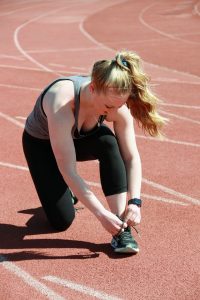Are shoes really that bad? Should we abandon them completely?
By Amanda Regnier
One of the most overlooked parts of a well rounded training program is our feet! Considering our feet are the foundation for our entire body, and a part of our body commonly injured, it makes sense they should be given at least a little attention.
Why are shoes so bad?
Our feet our full of little nerves which we stimulate when when we displace the skin on the bottom of them (like when barefoot walking). These nerves are crucial to detecting vibration (during dynamic movement) and help us with things like balance and regulating how hard we hit the ground when we walk and run. Basically, these nerves help us produce movement! However, when we put on shoes, we are BLOCKING that sensory feedback from getting to our central nervous system. Essentially, we are depriving our feet of feedback from the environment. This not only affects balance and movement patterns but also our ability to regulate forces. For example, we may end up running much “heavier” or with greater impact forces into the ground than necessary.
The issue here is that when we are hitting the ground with greater impact than we need, we can start to get injuries such as shin splints, Achilles’ tentonitis, plantar faciitis. A great example of this is movement specialist, Dr. Emily Splichal’s experience with Cirque du Soleil in Los Angeles.
Cirque du Soleil is known for having very few injures among performers. But, after a recent stage upgrade in their training facility, the number of impact related injuries skyrocketed! After examining the stage, they discovered that the support beams under the stage had less “give” (harder surface to land on) than the places of the stage without the support beams. This meant that the performers could not predict how hard / soft of a landing they needed, and would often hit the ground significantly harder than necessary. Once revamping the stage and testing it so that each inch of the stage was a uniform landing surface, all the injures went away. Similarly, when our feet can feel the impact of the surface we are moving on, we can regulate how hard we hit the ground. BUT, when our shoes are blocking this feedback, our feet have much greater difficulty regulating these forces. We can end up hitting the ground with much greater forces than needed, resulting in injury.
Why do we wear shoes?
Unfortunately, we are conditioned to believe that we NEED to cushion our feet in order to “protect” them. Sure, this is true to an extent. We absolutely cannot walk around on the street or in a park without being concerned about stepping on hazards. However, it is a complete myth that our feet are not capable of handling some level of impact forces from the ground. The right amount of these forces can actually help our feet get stronger! When we wear our “new, ultra soft, super cushiony” shoes we block all the sensory feedback to our feet. We end up striking the ground harder causing more impact on our knees and hips. And, the little muscles in our feet, that contract through vibrations, start to get weaker. This can result in feeling like we need MORE cushion in our shoes to support our weak feet, when in fact what we should be doing is strengthening our feet.
What can you do?
A great way to start incorporating more barefoot training into your life is starting at home. Try ditching socks, slippers, shoes around the house or in the gym. Notice I did NOT say take up barefoot running! Since many of us are accustomed to running in shoes, our feet are likely not strong enough for full-on barefoot running. However, there are still other ways to train them.
During sessions in the gym, I ask all my clients to take their shoes off during most of the workout. Generally, we only wear them for things like box jumps, broad jumps, and sled pushes. I also include a foot routine in their programs. This includes walking on their toes, heels, inside / outside of the foot, cross overs (rolling over the subtallar joint). Also “roll up’s” which is rolling up from your heel straight up to your big toe without the heel falling to the outside of your foot. These, along with various, short balance exercises, bring awareness and proprioception back to the feet. This serves to not only strengthen, but also increase the ability to regulate impact forces.
